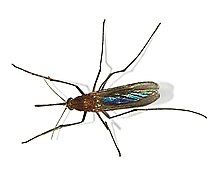The examples and perspective in this article deal primarily with the United States and do not represent a worldwide view of the subject. (October 2021) |
| Culex pipiens | |
|---|---|

| |
| Scientific classification | |
| Domain: | Eukaryota |
| Kingdom: | Animalia |
| Phylum: | Arthropoda |
| Class: | Insecta |
| Order: | Diptera |
| Family: | Culicidae |
| Genus: | Culex |
| Subgenus: | Culex |
| Species: | C. pipiens
|
| Binomial name | |
| Culex pipiens | |
Culex pipiens is a species of mosquito commonly referred to as the common house mosquito or northern house mosquito. Native to Africa, Asia and Europe, it is now widely distributed in temperate regions on every continent except Antarctica[1] and is one of the most common mosquitoes found in human habitats in temperate parts of the northern hemisphere.[2] A major vector of some viruses, it can be abundant in cities, especially those with poor wastewater management.[3] It is the most common mosquito to the northern regions of the US.[4] Culex pipiens is the type species for the genus Culex.
Culex pipiens' diet typically consists of vertebrate blood. They often consume the blood of humans, but prefer the blood of birds that are closely linked to human interaction, such as doves and pigeons.[5] Furthermore, at the end of the summer and the start of the fall season before it is time for them to overwinter, C. pipiens subsist on nectar and other sugary food sources in order to store fat.
In California populations, it was shown that most females of C. pipiens do not enter reproductive diapause during the winter, which differs from other mosquito species, such as C. stigmatosoma or C. tarsalis. Most of them overwinter in a stage of host-seeking arrest.[6] The practice of overwintering tends to vary based on location, and in effect temperature and the period of time per day an organism receives sunlight, also known as the photoperiod.[6] Parous females may overwinter together with nulliparous.[7] Overwintering mosquitoes are considered as hibernating by mosquito scientists.[7]
Typically, mosquitoes copulate when temperatures are the most temperate, and many species begin breeding when temperatures reach 50 °F (10 °C). Because of this temperature condition, mosquito breeding seasons vary by region and climate characteristics of a given area.
- ^ https://www.ecdc.europa.eu/en/infectious-disease-topics/related-public-health-topics/disease-vectors/facts/mosquito-factsheets/culex-pipiens
- ^ https://www.ncbi.nlm.nih.gov/pmc/articles/PMC9108678/
- ^ https://www.ecdc.europa.eu/en/infectious-disease-topics/related-public-health-topics/disease-vectors/facts/mosquito-factsheets/culex-pipiens
- ^ Cite error: The named reference
:0was invoked but never defined (see the help page). - ^ Cite error: The named reference
:2was invoked but never defined (see the help page). - ^ a b Cite error: The named reference
:7was invoked but never defined (see the help page). - ^ a b Andreadis, Theodore G.; Armstrong, Philip M.; Bajwa, Waheed I. (2010). "Studies on Hibernating Populations of Culex pipiens from a West Nile Virus Endemic Focus in New York City: Parity Rates and Isolation of West Nile Virus". Journal of the American Mosquito Control Association. 26 (3): 257–264. doi:10.2987/10-6004.1. ISSN 8756-971X. PMID 21033052. S2CID 25994060.